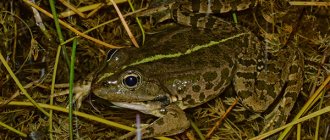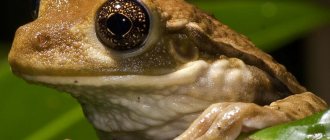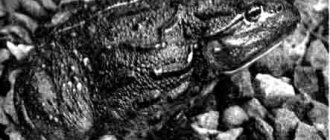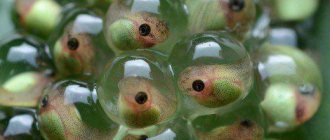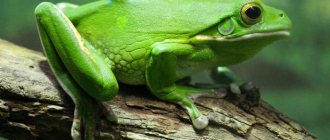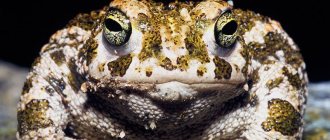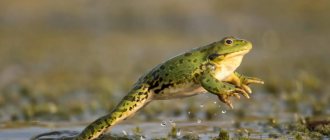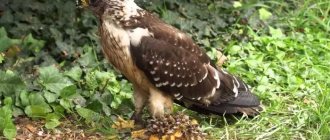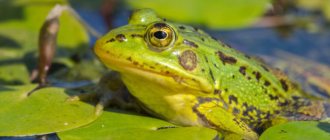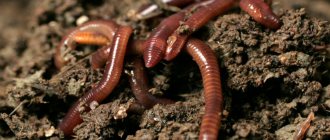- Wild animals
- >>
- Amphibians
of the goliath frog evokes some consternation; indeed, the frog princess looks like something out of a fairy tale. The enormous size of this amazing amphibian is simply amazing. We will try to consider all the most fascinating things, characterizing not only the appearance of the gigantic frog, but its disposition, behavioral characteristics, favorite places of settlement, nuances of reproduction and information about the size of its population, not forgetting to mention a number of interesting facts about this unusual animal.
Origin of the species and description
Photo: Goliath frog
The Goliath frog belongs to the order of tailless amphibians and belongs to the family of true frogs. The external parameters and dimensions of representatives of this family group are different. In most cases, almost all members of the family of true frogs are characterized by having moist and smooth skin. Scientists identify 395 varieties and as many as 26 genera in this family.
It is not for nothing that this frog is named after the biblical hero, the huge Philistine warrior Goliath (2.77 m tall), because in terms of its dimensions this amphibian occupies the first place of honor in the entire world space, being the largest frog on our planet. The indigenous population of the places where the frog settled affectionately nicknamed it “nia-moa,” which translates as “son.”
Video: Goliath frog
This frog became known relatively recently. Its discoverers are European zoologists, who discovered such a heroic creature only in 1906. Many people have a question: “How was it possible not to notice such a huge frog before?!” Perhaps the answer lies in the frog's character, which, despite its considerable size, is very timid, incredibly cautious and very secretive.
In this regard, very little has been studied about this amphibian; many of the nuances of its life activity are a mystery to us to this day. It is worth adding that although the Goliath frog is of considerable size, it is very similar in appearance to its smaller relatives.
Appearance and features
Photo: Great Goliath frog
It’s simply amazing, the length of the frog’s oval body is about 32 cm (this does not take into account the huge legs), on average, the mass of giant frogs varies from 3 to 3.5 kg, but there are specimens that are much more impressive, the weight of which can reach 6 kg, which is simply amazing. Looking at photographs of children holding a goliath frog in their hands, one is very surprised at the enormous size of these amphibians.
Interesting fact: If you measure the length of the Goliath frog along with its extended and powerful limbs, it will be all 90 cm or even a little more.
Regarding their appearance, goliaths are quite identical to other frogs (if you do not pay attention to their dimensions). The predominant skin color of the frog is dark green, where some brownish inclusions (shimmer) are visible.
The abdomen, chin and inner side of the paws have a lighter tone, which can be:
- off-white;
- beige;
- brownish yellow;
- greenish-yellow.
The dorsal region of frogs is wrinkled, with various tubercles visible on it. Frog eyes are quite large, have a yellow-golden iris and horizontally located pupils, and are protruding, as is typical of all frogs. The hind limbs are very impressive and long, their length can reach up to 60 cm, which is almost twice the length of the entire frog body. The toes are also large and oblong, they are connected by membranes (on the hind legs).
Interesting fact: Africans and French gourmets are on a real hunt for large and meaty goliath legs, which are considered delicacies. All this has a very detrimental effect on frog numbers.
As for sexual dimorphism, these frogs have it: males look more miniature, and the length of the body of females is much longer. Just imagine that the Goliath frog can make a giant three-meter leap!
The biggest toads
Toads that live in taiga swamps, tropical forests, and European and Asian countries are no smaller in size. The size and unusual coloring of some species causes surprise and even fear. Taking into account the parameters and descriptions, the following TOP of giants living in the wild has been compiled:
Blomberg's toad / Rhaebo blombergi
Otherwise it is called the Colombian giant. It is the largest toad of its species and inhabits the southwestern part of Colombia. This variety owes its name to the research scientist Rolf Blomberg.
The length of the amphibian is about 25-30 cm, and this giant weighs up to 1.5 kilograms.
The color ranges from brownish to burgundy-red with small spots. There are many photos on the Internet describing Blomberg's toad, but most of them are fakes.
Contrary to popular belief, this toad is not fat or oily. Her skin has a smooth texture. There is a kind of dividing strip on the body, dividing its body into two parts, the upper of which is lighter and the lower is darker. Another characteristic feature is white spots near the lip line, forming a “smile”.
Cane Toads / Bufo marinus
One of the longest representatives of the amphibian order, living in South America, Australia, the Philippines, and the Pacific Islands.
The size of this giant is about 20-22 centimeters, weight is about 1.5 kg. Lives in wet reed forests. Thanks to the powerful structure of the hind limbs, they are excellent jumpers.
Agha Toad / Rhinella marina
The modern name of the cane toad, living in Southeast Asia, on the Australian continent, the islands of New Guinea, Japan, the Caribbean and other oceanic islands. This species is native to South and part of North America.
Aga grows up to 38 centimeters (this size was recorded in 1991), and can weigh up to 2.65 kg. It feeds on arthropods, invertebrates, small animals such as rodents, and carrion. Very poisonous. The entry of its poison into the human body can cause convulsions, paralysis or cardiac arrest.
Green and brown toads
This species can be found in Europe and southern Russia. Toads grow up to 15 cm in length. Their width is no less impressive. The favorite habitat of brown and green toads is swamps, peat deposits and reservoirs with a lot of silt.
These amphibians look unusual due to their peculiar coloring: their back and belly are grassy in color with white lines or reddish-burgundy, without spots. The skin is dry and lumpy. This species lives peacefully with humans and poses no danger to them.
Interesting fact: these toads hibernate in the summer, as they cannot tolerate elevated temperatures.
Mongolian toad / Pseudepidalea raddei
Found in the eastern part of Siberia, China, Mongolia, and other countries of northern Asia.
It reaches a length of about 9 cm. Moreover, the females of this species are much larger than the males. The body is flat in shape. The head is pointed in the front. The skin is lumpy. Color: grayish-olive, brownish or gray-green. Weight – approximately 100-150 grams.
Where does the goliath frog live?
Photo: African goliath frog
We are accustomed to thinking that swamps are preferable for frogs; they are not too picky and picky about their places of settlement and can live calmly and happily in polluted reservoirs, taking a liking to even simple puddles. All this has absolutely nothing to do with the Goliath frog; she very carefully and scrupulously chooses the places of her permanent deployment, responsibly approaching this most important procedure, on which her future frog well-being depends. Goliaths like only those water spaces where the water is crystal clear, has a certain temperature and is rich in oxygen.
Giant frogs love flowing waters, loving tropical waterfalls and rivers with rapid currents. When choosing a place of residence, the temperature of the water is of great importance, which should be kept in the range from 17 to 23 degrees plus. The presence of high air humidity (up to 90 percent) is also favorable for the life of this type of amphibian. Goliath frogs spend most of the daytime sitting on rocky ledges, which are constantly exposed to splashes from waterfalls and raging fast-flowing river systems.
As for the specific habitats of these frogs, these large-sized individuals are residents of hot African content, occupying a very small territory on it.
Goliaths inhabit:
- equatorial Guinea (especially the Gulf of Guinea);
- southwestern Cameroon;
- Gabon (scientists have an assumption that these frogs live here, but it has not yet been confirmed).
Slingshot changeable
it is also called the Brazilian slingshot. These frogs live exclusively in South America. They reach 20 cm in length, have a rather terrifying appearance, and have horns and a crest on their heads. The color is reminiscent of camouflage: green, brown with dark spots, blurry outlines.
Replacement slings are aggressive in nature. They are known for their excellent appetite. Birds, mice and even.. relatives are used. Frogs are not even bothered by the fact that the prey exceeds their size. Death by suffocation is not uncommon; the sling can neither swallow nor spit out its dinner.
INTERESTING Which fish has the most delicious and healthy red caviar
What does the goliath frog eat?
Photo: Giant Goliath frog
Since the goliath is very large, it needs a lot of food, because it has a heroic appetite. Hunting occurs mainly at dusk, apparently for safety reasons. Frogs look for prey both on land and in water. The predominant dishes on the menu are invertebrate animals and all kinds of insects.
So, the Goliaths will not refuse:
- larvae;
- spiders;
- crustaceans;
- worms;
- locusts;
- cockroaches;
- grasshoppers.
In addition to all of the above, the frog menu also contains other small amphibians, fish, scorpions, small rodents, lizards, small birds (or chicks) and even snakes. Goliaths have their own hunting tactics: when they see a snack, the frog overtakes the prey in a swift jump (can reach three meters in length). Jumping, massive frogs crush the victim, stunning it. Next, the goliath immediately proceeds to the meal, grabbing the snack, squeezing it with the help of powerful jaws and swallowing it whole, which is typical of the frog breed.
Goliaths, like other frogs, grab small insects with their tongues and swallow them with lightning speed. It should be added that many victims do not even see the frog in their field of vision. This is because the goliath is capable of attacking from afar, possessing incredible vigilance, and is very well camouflaged, completely merging with the rocky ledges located above the water.
Features of character and lifestyle
Photo: Goliath frog
Goliath frogs are accustomed to being cautious; they are always on the alert, and despite their large size, they have a fairly calm and timid character. When choosing a place on the rocks for daytime rest, amphibians, first of all, make sure that the view of the surrounding area is unobstructed, so they will immediately notice the ill-wisher and be saved. It must be said that frogs have excellent hearing, and their vigilance can be envied; they are able to see a moving enemy or prey at a 40-meter distance.
Catching a goliath is no easy task. Sensing the slightest danger, he immediately dives into the water, hiding in the seething raging stream, where he can stay for 10 to 15 minutes. When everything unpleasant is left behind, the tip of the frog’s nose and a pair of bulging eyes first emerge to the surface of the reservoir, and then the whole body appears. The frog moves in water using intermittent kicks, and on land by jumping. These amphibians are quite strong, because... easily overcome rapid and turbulent currents.
In general, it is very difficult to study the life activity of these gigantic amphibians, since they lead a very quiet and inconspicuous existence. Having chosen some rocky ledge that forms a waterfall, the goliath can sit on it for a long time without a single movement, which is what it usually does during the day, and at night it searches for food. Frogs do not slide off wet stones because... their front paws are equipped with special suction cups, and their hind paws have membranes. All these devices add stability to them, or rather, perseverance.
Interesting fact: The Goliath frog is literally very quiet because... doesn't make any sounds at all. The quiet goliath does not have special vocal resonators that its relatives have, so you will not hear croaking from it.
How do they reproduce?
By the time of puberty, females reach the most impressive sizes. They go to spawn where the water is not very bubbling. Here you can safely lay eggs. The size of each egg is impressive: each of them is comparable to a pea. It is surprising that the eggs are colored heterogeneously: on one side they are gray-blue, and on the other they are yellowish. Where the color is yellow, there is a substance with a sticky consistency. Thanks to this stickiness, the caviar is securely attached to stones or algae.
The breeding season occurs during the dry season. Egg laying lasts about 5-6 days. During this time, the fertile female manages to lay about 10 thousand eggs. Once the process is completed, it takes a little over two months for new adults to grow.
The eggs hatch into small tadpoles 8-9 mm in length, which actively feed and grow rapidly. Their diet consists of algae and small plants. After 45 days, their tail disappears, and at this time the length is already 5 cm. In the process of growth and development, the gills disappear, and nutrition gradually becomes the same as that of adult goliaths.
Social structure and reproduction
Photo: Great Goliath frog
Scientists believe that goliath frogs are territorial creatures, i.e. Each frog individual has its own home area, occupying about 20 square meters. There she is constantly stationed and hunts. Goliath frogs begin breeding during the dry season. It has not yet been possible to figure out how silent gentlemen call young ladies to them. Scientists only know that the fertilization process takes place in water.
A female can reproduce up to 10 thousand eggs (eggs) with a diameter of at least 5 mm during one season. The laid eggs are attracted in clumps to the bottom of streams. The incubation period is not known exactly, but according to some data it is about 70 days. The length of each born tadpole reaches approximately 8 mm; their mouth is equipped with suction cups on the sides, with the help of which the little ones attach to underwater stone ledges. Thanks to their strong and muscular tail, they can withstand fast currents. Tadpoles feed on aquatic vegetation.
The process of transformation into frogs occurs when the tadpoles reach 5 cm in length, then they lose their tail. Without a tail, small frogs have a length of 3.5 cm. Goliaths become sexually mature when the length of their body reaches 18 cm in length. The average lifespan of a frog is about 15 years.
Interesting fact: There is recorded information that the maximum lifespan of the Goliath frog was 21 years. This is, of course, an exclusive case, but very impressive.
Long-legged litoria
Perhaps this beauty can compete even with the frog princess. Unfortunately, it can only be found in New Guinea and Australia. It has quite impressive dimensions - maximum length 14 cm.
Females are often larger than males. They have a bright green color. They live mainly in the forest among trees; it is very difficult to see the long-legged shore in the foliage, even if they sometimes go down to the ground for prey. They are active in the dark.
INTERESTING 10 animals that were “thrown out” from the Red Book in 2021
Natural enemies of goliath frogs
Photo: Goliath frog in water
Although the Goliath frog is a giant among its relatives, it cannot be called bold and courageous. She is very timid and has a gentle disposition. Among its enemies in its natural habitat are crocodiles; they are not averse to snacking on such large, fleshy amphibians. Sometimes large feathered predators attack goliaths from the air, but catching this frog is not an easy task. Goliaths are damn careful, very attentive.
Frogs lead a secretive, quiet life, skillfully camouflaging themselves on rocky water ledges. From afar, the goliath can sense and see danger, thanks to its acute hearing and excellent vision. The frog can distinguish its enemy from a forty-meter distance, which often saves its life, because it immediately disappears under the water.
The most dangerous, bloodthirsty and insatiable frog enemy is man, because of whom the number of goliaths is sharply declining. The indigenous African population hunts these amphibians because... their meat is considered a delicious delicacy. They kill frogs using poisoned arrows, set nets and hunting rifles. Not only Africans eat frog meat, there are many gourmets around the world who are willing to pay huge sums to taste this delicacy. Frogs are caught not only for gastronomic purposes; they are bought by collectors of exotic animals to be kept in captivity.
All this is very sad, because the mighty Goliath suffers precisely because of its size, which so attracts and intrigues people. Due to its large size, it is more difficult for the frog to hide, and it is not as dexterous as its small counterparts. Making huge jumps, goliaths quickly get tired, exhausted and run the risk of being caught.
Population and species status
Photo: African goliath frog
No matter how bitter it is to realize, the population size of the gigantic frog is very depressing; every year there are fewer and fewer of these amazing creatures. The reason for this is people’s selfish and unprecedented interest in these unusual amphibians, which attract attention due to their enormous height and weight by frog standards.
Interesting fact: There are disappointing statistics that, from the 80s of the last century to the present day, the number of goliath frogs has decreased by half, which is alarming.
Human impact on goliaths occurs both directly (poaching, trapping) and indirectly (human economic activity). Africans eat these frogs, hunt them for the purpose of selling them to gourmets and restaurants in other countries, who pay them exorbitant amounts of money for it. Exotic lovers catch goliaths for fun in order to add such unusual animals to their private collections, where, in most cases, the frogs die, because... maintaining them is very difficult and costly.
Any zoo strives to get this frog as its property in order to surprise visitors. People don’t think about the fact that these gentle creatures are very picky about where they live, so they most often die in captivity. A lot of Goliath frogs were exported to the United States, where the Americans organized frog jumping competitions, destroying many of these amphibians.
People are invading natural biotopes, cutting down tropical forests, polluting river waters, so there are fewer and fewer places left where the goliath frog can live freely and happily, because it lives only in the purest water with a high oxygen content. Due to rapid agricultural activity, people are displacing many animals from their usual places of deployment, this also applies to the goliath, whose distribution area is already very microscopic. Based on all of the above, only one conclusion suggests itself - the goliath frog needs certain protective measures in order not to completely disappear from the Earth.
Protection
This amphibian was taken under the protection of the law. Currently, no more than 300 specimens per year are allowed to be exported from natural habitats, but smuggling becomes an obstacle to this. The fact is that restaurateurs are willing to pay $5 for one copy, and for the local population this is an impressive amount, so the decline in numbers continues. Moreover, the largest representatives are caught, which affects the size of the specimens of the entire population.
Another problem is that logging is constantly destroying the natural habitats of goliath frogs. The habitat is reduced annually by 80 thousand hectares. No less dangerous are the agrochemicals that poachers use to catch fish. These substances pollute rivers, causing the death of amphibians and making the waters uninhabitable. The World Wildlife Fund is trying to prevent such an environmental disaster. If people become more conscious, then the largest frog in the world will be able to exist without the risk of extinction and will continue to amaze with its size.
